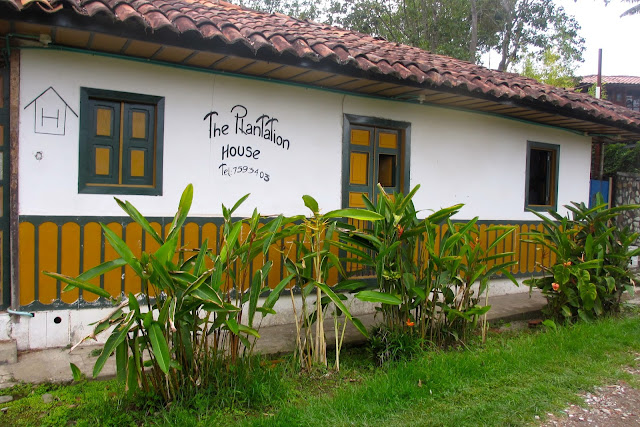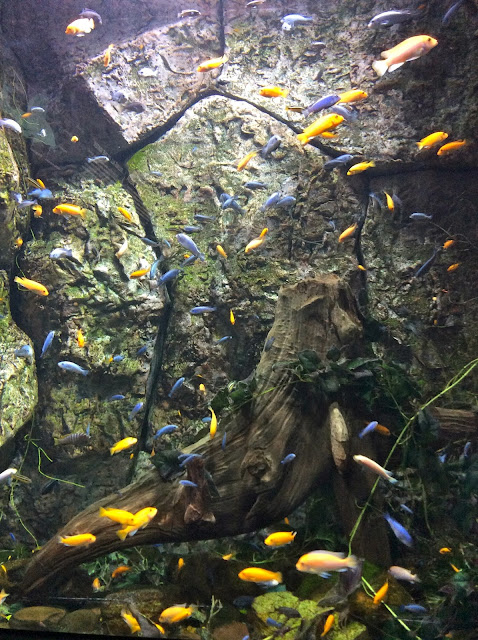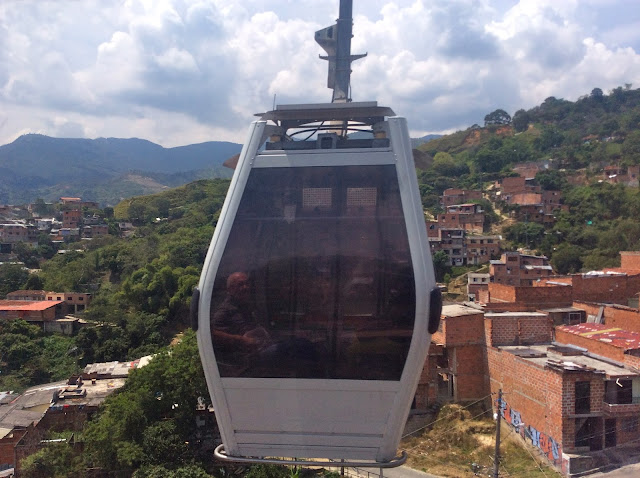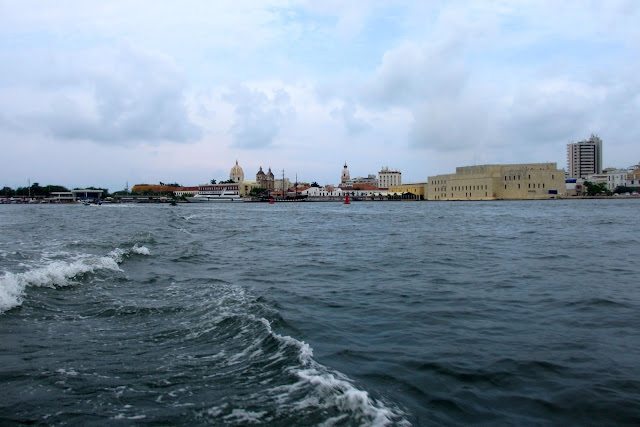Next, I took a taxi for $3.50 from the bus terminal in Tulcán to Immigration, and was stamped out of Ecuador. I crossed the bridge below and received my 90 day tourist visa into Colombia.
Next I changed a $20 bill for Colombian pesos at the border (the vultures are always awaiting), where I was shorted almost $5 in the process. I needed the Colombian money in order to catch a bus, but the colectivo I took to the bus station would have accepted dollars.
Colombian money was a challenge for me at first, but quickly became an easy currency to use. Every dollar is worth nearly COP$3000 right now. So COP$1000 equals about 33 cents. I brought about a hundred dollars into Colombia but never received a very good exchange rate for my dollars. I always got the best value when I used my debit card in a Colombian ATM machine.
Anyway, after getting stamped into Colombia, I took a colectivo to the Bus Terminal in Ipiales for COP$1800, or about 75 cents.
I went to the Bolivarian bus line and paid COP$34,000 (a little more than $10) for a bus ticket to Popayán. The clerk asked for COP$38,000 but I'd read a few blogs that suggested bargaining and I did so with success. That being said, buses are more expensive in Colombia than they are in Ecuador, and there is no discount offered for being "de la tecera edad," as there is in Ecuador. I took the bus below on the 8 hour ride to Popayán.
Having been on an all night bus in order to get to Colombia, then being on another bus for the whole next day, I was totally exhausted by the time I arrived in Popayán about 7 pm on Wednesday evening, October 21.
Luckily my friends, Hector (who is Ecuadorian!), Maria, and their son Pedro greeted me warmly when I arrived at their home. After a delicious home made dinner I fell sound asleep and did not awaken until 7 am the following morning. Below are photos of the wonderful Colombian family who hosted me during the four days I spent in Popayán.
Pedro and his girlfriend Veronica took me on a fabulous tour of Popayán the day after my arrival.Hector and Maria bought their home in Popayán over 25 years ago and raised their two sons here.
Hector, below, emailed with me back and forth the whole time I rode on the bus from Ipiales to Popayán. He truly shepherded me into his city. Below he's seen with the sister of a friend they both supported for electoral office in Popayán. Colombia's elections took place Sunday, October 24.

Below the lovely Maria is shown with her father, 92 years old! Maria's father knows all of Colombia's legendary musicians and introduced me to their music on Sunday afternoon. We listened to their songs on YouTube together.
Popayán is a beautiful colonial city, often called the "White City" because of its chalk white facades. It sits beneath the towering mountains in the Valle de Pubenza, and is second only to Cartagena as Colombia's most impressive colonial settlement.
Founded in 1537 by Sebastián de Belalcázar, the city became an important stopping point between Cartagena and Quito. Popayán is also known as Colombia's "City of Presidents, Poets and Priests," because of illustrious citizens that hail from this city.
Its mild climate attracted wealthy families from the sugar haciendas of the hot Valle de Cauca region. In the 17th century they began building mansions, schools and several imposing churches and monasteries in the city of Popayán. The city has numerous prominent universities.
Below is the mother of Veronica's friend, who allowed us free entry into Popayán's Museo de Historia Natural de la Universidad del Cauca (it's considered the best in Colombia).
Below is a statue of Francisco Jose de Caldas, a pre-eminent Scientist of the 18th century born in Popayán. Caldas died a martyr's death at the hands of the Spaniards.
Below is Parque Caldas, a lovely pedestrian square, and Popayán's main point of reference.
All of Popayán's museums are in houses of undeniable beauty.
Above are Veronica and Pedro at one of Popayán's best run restaurants, where the two encouraged me to try some of Colombia's favorite beverages and snacks.
Next, the Casa Mosquera houses the Museo de Arte Colonial e Historia. The Mosquera family is especially prominent in Popayán. General Tomás Cipriano de Mosquera was president of Colombia on four occasions between the years of 1845 and 1867.
Popayán suffered a very powerful earthquake in 1983, and many of it's buildings have been restored following this devastating earthquake.Guillermo Leon Valencia, son of Popayán poet Guillermo Valencia, was president of Colombia in the 1960's. There are two Valencia museums in Popayán, and they are dedicated to these different men.
Seen next are the Puente Humilladero and Puente de la Custodia, historic bridges next to the Museo Casa Valencia. The Puente de la Custodia dates to the 18th century.
Below is Popoyán's beautiful Iglesia San Francisco, which dates to the late 18th century.
I left Popayán on a minibus Monday headed for Cali. The trip took about 3 1/2 hours and cost COP$24, 000 (about $8). By the way, in my experience taxi fare in Popayán usually costs about COP$4000 or $1.33. Popoyán is not a very big city so distances are not great.
Cali has a population of about 2. 5 million and is Colombia's third largest city. Known for salsa, Cali also has many beautiful colonial buildings. I also enjoyed the ambience and restaurants of the part of Cali I stayed in, San Antonio.
I did not care for the hostel where I stayed, El Viajero, which played loud music and was definitely a youth scene. I found it overpriced as well, having paid COP$27000 for a bed in a dorm when the average is only COP$23000. Additionally, I was charged COP$4000 for a towel!
I found a hostel I really liked named Pajara Pinta that I'd stay in if I were in Cali again. Unlike the Uruguayan chain hostel El Viajero, the Pajara Pinta is not featured in popular guidebooks. I found it quiet, clean and appealing. This hostel not only has dorm rooms, but lovely private rooms for less than $20.00 night.
Below is a photo of the lovely young guide who took another person and myself out on a tour of Cali. She had grown up in Cali, and returned after being away for 15 years. She loves Cali and is elated now that all of the drug lords have been killed or incarcerated and Cali is thriving. I paid COP$30,000 for the tour and it was wonderful.
Below are some of the restaurants and other scenes in the neighborhood of Cali I enjoyed so much, San Antonio.
The tour of Cali included a trip to view the 26 meters tall statue of Cristo Rey above the city. Afterwards we walked through Cali's Centro, or downtown, at dusk.
Below is a statue of Spanish Conquistador Sebastián de Belalcázar, founder of Cali (as well as of Popayán). The statue depicts Belalcázar learning on his sword and pointing towards the ocean as he looks out over the city below.Below is the beautiful Iglesia La Merced, built sometime around 1545. It is a lovely example oftypical colonial construction of the time, with its thick, whitewashed walls. The church, in the shape of a cross, has a single nave with red wooden beams.
The most stunning building on the plaza is the French neoclassical gem the Palacio Nacional, also known as the Palacio de Justicia.
Dozens of majestic wax palms in the Plaza Cayzedo create a green oasis in the middle of Cali's gritty downtown. It was renamed in 1913 to honor the most famous independence figure from Cali, Joaquín de Cayzedo y Cuero.
After my visit to Cali I decided to head for Salento, in the coffee producing area of Colombia. I took a minibus to Armenia then transferred to a bus going to Salento. The trip took about 7 hours and I think I paid about COP$30,000. It's harder to negotiate prices for smaller buses in Colombia, so I paid the fee requested.
The hostel I stayed at in Salento was The Plantation House, and I recommend this hostel enthusiastically. Staff greeted me incredibly warmly and gave very helpful suggestions for restaurants to eat at and places to visit. There were only 4 of us in the women's dorm and I enjoyed the travelers I met from Norway, Italy, the Netherlands, Australia and Colorado very much.
The kindness of those I met in Salento nourished me throughout my travels in the larger cities of Colombia. While it was quite rainy during my stay, I enjoyed the coffee tour offered for $10.
After a few days in Salento I headed on a minibus directly to Medellin. The bus left Salento from a location close to The Plantation House about 9 am and arrived in Medellín about 5 pm. I think I paid COP$40,000 for the fare. It was a joy to avoid a layover in the larger coffee towns of Armenia or Pereira. I appreciated our trip through Pereira, however, because of having had a friend in the Dominican Republic who grew up in Pereira.
I stayed in a quiet hostel recommended to me by staff at The Plantation House hostel in Salento. The name of the hostel is El Tamarindo, and it's in Medellín's popular El Poblado area. I didn't find the staff that warm or friendly at first, but they improved after a few days. The hostel is not especially cozy, yet it was quiet, and inexpensive.I stayed in the 3rd floor dorm for just COP$23,000 nightly. The hostel faced a river and large trees. The branches of the trees overhung the road, brushing the windows of the dorm. I slept very well ever night I was there, and loved the sounds of the birds chirping in the morning.
Also, a man from Georgia (near Russia) came to the hostel and we had great astrology talks. He is nearly 50 and travels alone extensively throughout the world. We had much to discuss. I so rarely run into an older traveler and it was great fun to connect with him. One never knows what miracles one might encounter while touring a new country. That's one of the reasons I delight in traveling.
Medellín is a modern city with many amenities that appeal to people on a world wide basis. Tourists from Bogotá came to visit Medellín the weekend I was there, and were filled with envy for Medellín's advanced transportation system.
While I loved Medellín's metrocable system, I could not live in Medellín. It's a very modern city, and its restaurants (at least those in El Poblado) cater to British and American tourists. I found El Poblado beautiful yet somehow lacking in soul and rather expensive. That being said, I enjoyed the 4 days I spent in Medellín immensely.
The Artist and Sculptor Fernando Botero has donated many works to his home town of Medellín. Below are sculptures seen at Medellín's Botero Plaza.Medellín's Museo Antioguia displays much of Botero's art.
Below is the painting titled, "The Death of Pablo Escobar."
Honestly, I prefered the works of other artists on display, such as this painting by Horacio Longas.
I also appreciated Humberto Cháves Cuervo's depiction of a mother and child.
I found this photograph of indigenous children at their first Catholic communion heart-wrenching.
Below is a courtyard of the Palacio de la Cultura Rafael Uribe Uribe.
Medellín's Parque Explora is an interactive science museum modeled after San Francisco's Exploratorium. It houses South America's largest aquarium. I really love aquariums so enjoyed the afternoon thoroughly. A visit to the aquarium costs COP$20,000 or about $6.00.
The above photo was taken while visiting the "escaleras eléctricas" in Medellin, at Comuna 13. To get there I took the metro Linea B to the San Javier station. Then I took a colectivo up the hill and walked up several blocks to the escalators.
City leaders sought to improve the quality of life in the comunas in a variety of innovative ways. Many of its working people have been besieged by drug trafficking gangs with links to former paramilitaries. Whole families have been displaced within the city due to urban violence.
The creation of open air escalators in the neighborhood has been used to enable residents greater mobility. Artists from throughout the world have come together to create the beautiful murals on display in the area.
Below are more photos taken that day, which was one of my favorite days of my trip to Colombia. A kind city employee took many photos of me while I was visiting!
After my visit to the escaleras eléctricas, I took the Linea J, which has 3 stops and travels to the top at La Aurora. Below are photos of the gondola like public transport system with a socio-economic purpose, connected to a metro. The system, consisting of gondolas, has eliminated eternal climbs up and down the mountains for low income city residents.
Another gondola system transports metrocable users across Medellín's beautiful Parque Arvi. I paid about $3 each way to ride on a gondola and visit the park.
Guatapé is a gathering place for those who own small farms in the area on the outskirts of Medellín. It is a popular tourist destination for Colombians. Each building has tiles along the facade's lower walls in bright colors and dimensioned images. Many of the tiles are cultural images of the farming heritage of the community.
The town of El Peñol was submerged as a result of this controversial hydro-electric project and a new town created. The tour took us to both a replica of the town that was submerged, and the town that was built to take its place. We visited a popular tourist destination known as La Piedra del Peñon before embarking on a boat tour of the reservoir.
The two young Panamanian men below, a physician and an attorney, were my friends throughout the day. They love visiting Medellín and remarked on how low the prices are in Colombia relative to those in Panama.
Lastly is a photo of our sparkling tour leader.
I took a round trip plane trip from Medellín to Cartagena for $80, saving myself 26 hours on the bus. Plane fares are inexpensive in Colombia and often a plane ticket costs about the same as taking the bus. I would recommend that anyone visiting look into taking flights. Colombia a huge country!
Below is San Pedro Cathedral, in Cartagena. I took so many photos of beautiful plazas and churches in Cartagena and am only posting a smattering of images.
Below is Cartagena's Museum of Modern Art.
Below is a self-portraint of reknowned Cartegena Artist Enrique Grau.
I also went to Cartagena's inquisition Museum:
My favorite activity visiting Cartagena was a snorkeling trip to the Rosario Islands. We were told that Colombian pop star Shakira owns a house on one of these islands. They seem glamorous! I didn't take photos of the snorkeling, because of not having an underwater camera. Snorkeling was a thrilling adventure. And I greatly enjoyed my companions on the boat that day--most of them Argentinians.
We had a late lunch on the beach after returning from our snorkeling trip.
The day's boat tour cost about $30. The price was raised about $6 several times, but in the end it came out to about $30. There were some rough parts, including the hurry of the person propelling the boat, as he seemed to dislike his job. Also, there was a fee of $4 imposed by the government for leaving the harbor that was not included in the trip's cost. Even with the hassles, the trip was worth it.
I stayed at the Hostel Green House while in Cartagena, in the old city. I very much enjoyed staying in the walled city of Cartagena and preferred it over staying in Gethsemene (just outside the old city). The Hostel Green House is quiet and small, and I liked staying there, especially my first 4 nights.
I returned one last night after being away in Santa Marta. Cartagena was celebrating its Independence Day on November 11, so then the hostel was busier and not as quiet. The breakfast was still great though, and it was included. The cost for staying in the dorm was COP$40,000, or about $13. Everything is more expensive in Cartagena.
This Colombian family lives in Utah and are visiting relatives in Colombia. We rode on the same bus together back to Cartagena from Santa Marta.
Gabriel García Márquez lived in Cartagena and his presence is very much alive in this city.
Below is El Castillo San Felipe de Barajas, the largest fortress built by the Spaniards in South America. A complex system of tunnels connected points of the fortress in order to distribute provisions. So glad I went with a young German traveler to visit the fortress at dusk. We explored some of the tunnels together too. By the time we climbed back down the fortress it was dark, so I was glad to have a tall young man by my side. However, I felt safe in Cartagena. Cartagena is full of tourists and there are always people walking in the streets.
One day I took a boat out to Playa Grande beach (the round trip cost was about $2) and spent the day with a lovely couple from Bogota, Davis and Jazmin. We had almuerzo together, too. It was an unforgettably happy day. And now we're friends on Face Book.

I had my own room at the La Casa de Felipe, where I stayed in Tananga. I loved staying in Tananga and really enjoyed La Casa de Felipe. My room cost just COP$45,000 or about $15 per night.
Below are photos taken in the historic city of Santa Marta.
One of my most worthwhile afternoons in Colombia included a visit to the estate of Quinta de San Pedro Alejandrino, where Simón Bolívar died. The ladies at the hostel said I should take a taxi there, but I figured out how to take a bus from the center of Santa Marta. It all worked out great.
Below is the bedroom in which Simón Bolívar died of tuberculosis at the age of 47.
In the beautiful painting above, the spirit of Simón Bolívar is shown rising from the dead.
After several days in Tananga (outside of Santa Marta), I took a bus to Palomino, several hours east of Santa Marta on the Caribbean coast. I stayed at the Dreamer Hostel. At first I thought I'd made a big mistake. It looked like a young persons' scene.
I did take a tour down a river in an inner tube for about $8, and saw toucans, flamingos and herons. A young man took me on the back of his motorcycle to the point at the river where we disembarked, and he accompanied me down the river.
Being on the back of a motorcycle brought back happy memories of 2 years living in the Dominican Republic! The Dreamer Hostel organized some good tours, I decided.
The second evening there, I had a few drinks during Happy Hour, and enjoyed talking to an "older" woman, who was probably 40. Two young guys playing pool in the bar asked me to join them and I ended up having a fabulous evening. One young Colombian woman told me that I was her role model for how she wanted to live when she is my age.
The Colombian women below are spreading canned chile and cheese over patacons (fried plantain formed into tasty rounds) they bought from the restaurant at the Dreamer Hostel. They are from Bogotá and came to enjoy the weekend.
Below are poolside scenes at the Dreamer Hostel, designed by Italian businessmen to resemble an expensive resort. While it looks expensive, it works well for young backpackers on a budget.
I was assigned the bottom corner bunk of the dormitory below, and I slept very well. The young people staying at this hostel were quiet and well mannered. The dorm cost COP$23,000 per night.
I spent about $3 for a bus back to Santa Marta from Palomino. The problem was that the bus dropped me off in the middle of no where. I was told there was a tax on bus drivers going into the city center, where I thought I could catch a bus to Tananga, so they didn't go that far. I ended up taking a taxi back to my hostel in Tananga, for another $3. Occasionally it's necessary to take a taxi.
After spending one more night in Santa Marta, I went to Cartagena for one more night. It was fun to backtrack a little and I was able to do some things I didn't get a chance to do earlier.
I flew from Cartagena to Cali and I am so glad I did. By the way, it's easy to take a colectivo to the airport instead of a taxi, saving about COP$8000. I enjoyed the colectivo, too.
Anyway, after arriving in Cali I took a 3 1/2 hour bus ride to Popayán. The family I'd stayed with previously enjoyed the gifts of a carry-all and tee shirts I brought with me from Cartagena. They were impressed with all of my travels.
This dear Popayán family seemed especially relieved that all went well on my travels. Colombians still seem to worry their country is dangerous after the drug war years. They were being protective of me. I was happy to see that they were happy I had such a great time!
I spent about 3 weeks running all over Colombia doing every which thing and spent around $700 including several air flights. I also bought $100 worth of clothes in Popayán.
After staying in Popayán one more night with my friends I returned to Ipiales on a bus. The Bolivariano Bus employee was unhelpful and Taxi Belalcazar was leaving at 6:30 am, so I went with Taxi Belalcazar. They charged 30,000 pesos (4,000 less than Bolivariano) and the trip went very well. In fact it took less time than expected. It's good to be flexible when taking a bus in Colombia.
About 3 pm I arrived in Ecuador, then took a bus from Tulcán to Otovalo and another bus to Cotacachi. Friday night about 8 pm I arrived in Cotacachi.
Karla, seen on the left below, was kind enough to host me at her home. Renate kept my packs for the past year (!), and I finally went to her house and retrieved them. Karla, Renate and I went hiking all day Sunday. Monday morning I had breakfast with my dear friend Jennifer.
Finally, on Monday night I flew LAN Airlines from Quito and arrived in Cuenca about 7:30 pm.
So that's all for now. Right now I'm house sitting with Artie the cat, in a gorgeous condominium where I've stayed previously. I am pretty much holed up (in luxury) here in Cuenca until the middle of January. Who knows what I'll be up to then, except that I am thinking of looking for a place to live in Loja. So I'll probably head for Loja again in January.
In the meantime, I appreciate your taking the time to read my blog and look at all of the photos in this update. Wish you all the best over the Thanksgiving holiday and I'll keep in touch!






















































































































































No comments:
Post a Comment